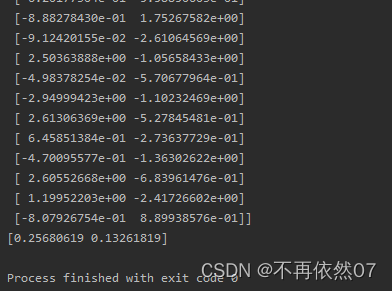实现功能:
python对数据清洗以及数据编码(具体实现方式可查看前两篇文章)后的变量进行PCA降维,并进行可视化展示。
实现代码:
# 导入需要的库
import numpy as np
import pandas as pd
import seaborn as sns
from sklearn import preprocessing
import matplotlib.pyplot as plt
from sklearn.decomposition import PCA
def Read_data(file):
dt = pd.read_csv(file)
dt.columns = ['age', 'sex', 'chest_pain_type', 'resting_blood_pressure', 'cholesterol',
'fasting_blood_sugar', 'rest_ecg', 'max_heart_rate_achieved','exercise_induced_angina',
'st_depression', 'st_slope', 'num_major_vessels', 'thalassemia', 'target']
data =dt
pd.set_option('display.max_rows', None)
pd.set_option('display.max_columns', None)
pd.set_option('display.width', None)
pd.set_option('display.unicode.ambiguous_as_wide', True)
pd.set_option('display.unicode.east_asian_width', True)
print(data.head())
return data
def data_clean(data):
# 数据清洗
# 重复值处理
print('存在' if any(data.duplicated()) else '不存在', '重复观测值')
data.drop_duplicates()
# 缺失值处理
# print(data.isnull())
# print(data.isnull().sum()) #检测每列中缺失值的数量
# print(data.isnull().T.sum()) #检测每行缺失值的数量
print('不存在' if any(data.isnull()) else '存在', '缺失值')
data.dropna() # 直接删除记录
data.fillna(method='ffill') # 前向填充
data.fillna(method='bfill') # 后向填充
data.fillna(value=2) # 值填充
data.fillna(value={'resting_blood_pressure': data['resting_blood_pressure'].mean()}) # 统计值填充
# 异常值处理
data1 = data['resting_blood_pressure']
# 标准差监测
xmean = data1.mean()
xstd = data1.std()
print('存在' if any(data1 > xmean + 2 * xstd) else '不存在', '上限异常值')
print('存在' if any(data1 < xmean - 2 * xstd) else '不存在', '下限异常值')
# 箱线图监测
q1 = data1.quantile(0.25)
q3 = data1.quantile(0.75)
up = q3 + 1.5 * (q3 - q1)
dw = q1 - 1.5 * (q3 - q1)
print('存在' if any(data1 > up) else '不存在', '上限异常值')
print('存在' if any(data1 < dw) else '不存在', '下限异常值')
data1[data1 > up] = data1[data1 < up].max()
data1[data1 < dw] = data1[data1 > dw].min()
# print(data1)
return data
def data_encoding(data):
#========================数据编码===========================
data = data[["age", 'sex', "chest_pain_type", "resting_blood_pressure", "cholesterol",
"fasting_blood_sugar", "rest_ecg","max_heart_rate_achieved", "exercise_induced_angina",
"st_depression", "st_slope", "num_major_vessels","thalassemia","target"]]
Discretefeature=['sex',"chest_pain_type", "fasting_blood_sugar", "rest_ecg",
"exercise_induced_angina", "st_slope", "thalassemia"]
Continuousfeature=["age", "resting_blood_pressure", "cholesterol",
"max_heart_rate_achieved","st_depression","num_major_vessels"]
df = pd.get_dummies(data,columns=Discretefeature)
print(df.head())
df[Continuousfeature]=(df[Continuousfeature]-df[Continuousfeature].mean())/(df[Continuousfeature].std())
print(df.head())
df["target"]=data[["target"]]
print(df)
return df
def PCA_analysis(data):
# X提取变量特征;Y提取目标变量
X = data.drop('target', axis=1)
y = data['target']
pca = PCA(n_components=2)
reduced_x = pca.fit_transform(X) # 得到了pca降到2维的数据
print(reduced_x.shape)
print(reduced_x)
yes_x, yes_y = [], []
no_x, no_y = [], []
for i in range(len(reduced_x)):
if y[i] == 1:
yes_x.append(reduced_x[i][0])
yes_y.append(reduced_x[i][1])
elif y[i] == 0:
no_x.append(reduced_x[i][0])
no_y.append(reduced_x[i][1])
font = {'family': 'Times New Roman',
'size': 16,
}
sns.set(font_scale=1.2)
plt.rc('font',family='Times New Roman')
plt.scatter(yes_x, yes_y, c='r', marker='o',label='Yes')
plt.scatter(no_x, no_y, c='b', marker='x',label='No')
plt.title("PCA analysis") # 显示标题
plt.legend()
plt.show()
print(pca.explained_variance_ratio_) # 输出贡献率
if __name__=="__main__":
data1=Read_data("F:\数据杂坛\\0504\heartdisease\Heart-Disease-Data-Set-main\\UCI Heart Disease Dataset.csv")
data1=data_clean(data1)
data2=data_encoding(data1)
PCA_analysis(data2)
实现效果:



喜欢记得点赞,在看,收藏,
关注V订阅号:数据杂坛,获取完整代码和效果,将持续更新!

版权声明:本文为sinat_41858359原创文章,遵循CC 4.0 BY-SA版权协议,转载请附上原文出处链接和本声明。